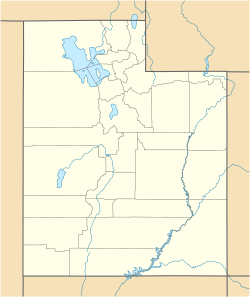Top Qs
Timeline
Chat
Perspective
Bechan Cave
Rock shelter in the United States From Wikipedia, the free encyclopedia
Remove ads
Bechan Cave is a single-room sandstone rock shelter located at an elevation of 1,280 metres (4,200 ft) along Bowns Canyon Creek, a tributary of the Glen Canyon segment of the Colorado River, in Kane County in southeastern Utah in the United States.[1][2] The cave is roughly 31 metres (100 ft) wide, 9 metres (30 ft) high and 52 metres (170 ft) deep.[3][4] It has a single entrance that faces southwest[1] and is well-lit during the daytime.[3]
The cave holds alluvial deposits containing the remains of Pleistocene megafauna,[2] including mammoths,[4] ground sloths, and even-toed ungulates.[5] Archaeological excavation of the site in 1983 and 1984 by paleontologists Larry Agenboard and Jim Mead[6] unearthed animal bones, dung, hair, and teeth dating from 11,555 BCE to 9720 BCE, underneath "a few feet"[7] of cave fill, consisting of ceiling spall and wind-blown sand,[3] containing evidence of Holocene habitation from the Archaic period to the Basketmaker culture and possibly even by Navajo or Paiute.[1] Among the items unearthed were large dung boluses, similar in size to the dung of the African elephant, containing the stems of graminoids[5] and sedge (Carex).[8] The cave is also one of at least seventeen sites on the Colorado Plateau where Archaic-era Southwestern sandals have been discovered.[9]
The cave's name derives from a Navajo word meaning "big dung"[7] or "big feces".[4][10] The well-preserved dung layer was deposited over approximately 1,000 years by multiple animal species during a period characterized by the proliferation of oak and the decline of blue spruce and water birch.[5] The organic deposit consists primarily of Columbian mammoth (M. columbi) dung but also includes dung belonging to shrub-oxen (E. collinum), Shasta ground sloths (N. shastensis), Harrington's mountain goats (O. harringtoni), bighorn sheep (O. canadensis), cottontail rabbits, pack rats, and possibly equines.[3] With a thickness ranging between 4 and 16 inches (10–41 cm),[7] an area of more than 300 square metres (3,000 sq ft),[10] and a volume of 225 cubic metres (8,000 cu ft),[5][11] it is the largest coprolite deposit in North America.[4] Other macrofossils discovered in Bechan Cave include teeth and a bone, a "metapodial condyle", belonging to E. collinum.[12]
The cave is located inside Glen Canyon National Recreation Area[13] and, though it is rarely visited, is accessible on foot from Bowns Canyon.[14] The 5-mile (8.0 km) round-trip hike between Bowns Canyon, which can be reached from Lake Powell by boat, and Bechan Cave is considered moderately difficult.[14]
Remove ads
See also
References
External links
Wikiwand - on
Seamless Wikipedia browsing. On steroids.
Remove ads
